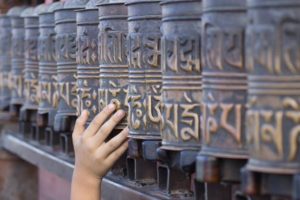
Buddhism
The founder of Buddhism was a royal prince born in 624 BCE in northern India – now a part of Nepal – who was given the name Siddhartha. He lived in the royal palace but when he was 29-years-old he moved into the forest to follow a life of meditation. According to Buddhist belief he attained enlightenment under the Bodhi Tree which grew in Bodh Gaya, India. It was requested of him to teach fellow pilgrims who were attempting to attain enlightenment. The Buddha as he was now called proceeded to teach the first Wheel of Dharma which included the Four Noble Truths. Later he taught the second and third Wheels of Dharma including the Perfection of Wisdom Sutras and the Sutra Discriminating the Intention. The teachings of the Buddha included 84,000 teachings with the intention of leading mankind to permanent liberation from suffering and finding nirvana.23 The First Council was convened after the Buddha’s death in order to preserve his teachings.24 The Second Council was convened about 100 years after the Buddha’s death when conflicts began to arise amongst the Buddhists. It is unclear what happened during this Council but a split occurred within the Buddhist community. The group who felt they were keeping the original spirit of the Buddha’s teachings became known as the Elders and eventually evolved into Theravada Buddhism. Those who taught a more lenient form of Buddhism in ways they felt were in tune with the Buddha’s intentions broke off from the others and became known as the Great Community. This break-off group eventually became Mahayana Buddhism. “Within 200 years of the Buddha’s death, there were 18 schools of Buddhism in India. … Moreover, Buddhism had now spread to places with different languages and customs, and therefore different perspectives on the dharma.”25
The Buddha’s teachings as well as those of Theravada Buddhism are in reality atheistic. However, the Buddha and Theravada Buddhism do not necessarily deny the existence of beings that could be called “gods.” Mahayana Buddhism on the other hand believes in a universe that is populated with celestial buddhas and bodhisattvas who are worshipped by followers as gods and goddesses. Included in this pantheon of gods and goddesses is the Buddha himself. Most of the Mahayana Buddhist deities are adapted from indigenous religions of Tibet, China, and Thailand as well as the deities of Hinduism.26
The First Council was convened after the Buddha’s death in order to preserve his teachings. It was at this Council that the Buddha’s teachings were divided into three categories known as pitaka. These categories include discourses, discipline, and higher knowledge. “The Tripitaka that was formed at this meeting is the same canon used by Buddhists today.”24
Evil according to Buddhism comes from the choices that mankind makes. The three basic roots of evil are greed, hatred, and delusion. It is the choices made by mankind from these roots that is the cause of suffering and evil in this world.27 The Buddha taught a doctrine that rejected the idea of a soul and instead taught a doctrine of reincarnation (often called transmigration) in which one takes on a new body in the next life. Nirvana is the final liberation from the cycle of death and rebirth according to Buddhism and it is the end of all suffering. Nirvana was described by the Buddha as “incomprehensible, indescribable, inconceivable, unutterable. … [In his teachings] the Buddha describes Nirvana as the place in which it is recognized that there is nothing but what is seen of the mind itself; where, recognizing the nature of the self-mind, one no longer cherishes the dualisms of discrimination; where there is no more thirst nor grasping; where there is no more attachment to external things.”28
——————–
23“History of Buddhism.” aboutbuddhism.org. About Buddhism, 2007. [http://www.aboutbuddhism.org/history-of-buddhism.htm/]
24“The first Buddhist council.” religionfacts.com. Religion Facts, n.d. [http://www.religionfacts.com/buddhism/history/first_council.htm]
25“The second Buddhist council.” religionfacts.com. Religion Facts, n.d. [http://www.religionfacts.com/buddhism/history/second_council.htm]
26“Do Buddhists believe in God?” religionfacts.com. Religion Facts, n.d. [http://www.religionfacts.com/buddhism/deities.htm]
27Nyanaponika Thera. “The Roots of Good and Evil.” Penang, Malaysia: Inward Path, 1999. [http://www.buddhanet.net/pdf_file/roots_goodevil.pdf]
28“Buddhist beliefs about the afterlife.” religionfacts.com. Religion Facts, n.d. [http://www.religionfacts.com/buddhism/beliefs/afterlife.htm]
